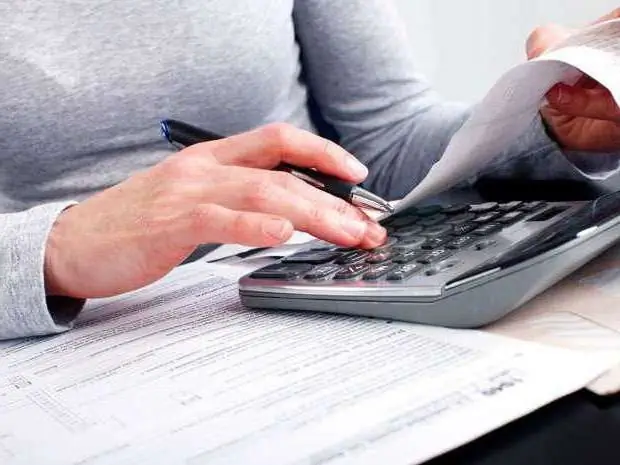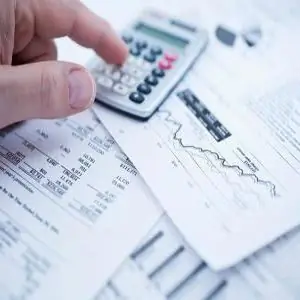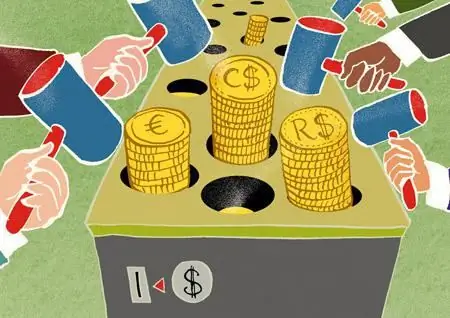2026 Author: Howard Calhoun | [email protected]. Last modified: 2025-01-24 13:10:37
The exchange rate is the relative value of the currencies of two states. In other words, it is the value of one currency, which is expressed in units of another.
Foreign Rate Setting Modes
It is worth familiarizing yourself with the existing exchange rate regimes:
• Based on gold parities. Currencies that are pegged to gold correlate with each other at a fixed rate. Previously, the gold standard was the automatic type of global market regulator.
• Fixed rate. The Central Bank determines the rate of the national currency. This mainly concerns the limits of free fluctuations in the exchange rates of the national currency, which is done for the purpose of macroeconomic stabilization. To do this, the Central Bank purchases or sells a specific amount of foreign currency.
• Floating exchange rate. It is determined as a result of unlimited fluctuations in supply and demand. In this case, the exchange rate will be the equilibrium price of the currency in the foreign exchange market. At the same time, fluctuations in the exchange rate, volumes of imports and exports, the statebalance of payments and trade balance are unlimited.
If the first two modes are clear to understand, then the floating exchange rate is worth studying in more detail.

What is a flexible exchange rate?
Floating or flexible exchange rate is a regime in which exchange rates in the market can change depending on supply and demand. In conditions of free fluctuations, they can rise or fall. It also depends on the conduct of speculative transactions in the market and the state of the balance of payments of the state.
Theoretically, the regime of freely floating exchange rates should be the reason for establishing an equilibrium rate. In this case, the country will have sufficient opportunities to regulate the economic situation in the absence of external influence. In reality, however, flexible exchange rates are causing destabilizing and unsustainable trends. The situation may be aggravated by the influx of speculative funds.
Concluding investment and trade agreements can become more difficult if partners are not sure of making a profit. For this reason, it is preferable for countries to regulate exchange rates using intervention. But quite often this escalates into the manipulation of the exchange rate to gain a competitive advantage in trade with other states.

Creating a floating exchange rate system
In 1976, the Interim Committee of the IMF met and reached the Jamaicanagreement. This procedure consolidated the demonetization of gold and the transition to floating exchange rates. In the Russian Federation, an appropriate regime was established by decree of November 15, 1991. The system of floating exchange rates was formed under the influence of the ratio of supply and demand available in the state's foreign exchange markets.
When carrying out commercial transactions in order to cover the currency risk, futures transactions began to be used. This method has gained popularity since the end of the 60s. This time was marked by the transition to a floating regime, the crisis of the Bretton Woods system, as well as the instability of the currency markets.
Reasons for creating a new system
Due to the instability of the foreign exchange markets in 1964, the convertibility of the Japanese and other world currencies was announced. Thus, the US has lost the ability to support the price of an ounce of gold. The state faced a rapid rise in inflation. Of course, the US government has taken a number of measures to combat this phenomenon, but they did not give a positive result.
US external debt increases every year, but the biggest crisis in the dollar was in 1970, which was due to lower interest rates. The following year, the state's balance of payments experienced a severe deficit. Free conversion of dollars into gold has been suspended.
Much has been done to save the Bretton Woods system. An intervention worth about 5 billion dollars did not produce results. After the devaluation of the dollar by 10%, developed countries made the transition to a floating exchange rate.

Crisis handling
Until 1973, it was possible to make good money on operations with monetary units. But there were problems in extracting speculative profit after fixed rates lost their relevance. At the same time, the regime of freely floating exchange rates led to the bankruptcy of many large banks. At the same time, a large number of financial institutions were seriously affected. After the system was officially recognized, international financial relations began to succumb to regulation.
The transition to a floating exchange rate eliminated most of the shortcomings and problems. Despite the advantages of this mode, they have some disadvantages. First of all, it is worth noting the high volatility of monetary units (the amplitude of fluctuations in value over a certain time). In most cases, this negatively affects international export-import operations.

The regime present in Russia
After the Russian default in 1998, the regulated currency regime was launched the following year. Since then, the government has been able to reduce the degree of negative impact of external conditions on the public sector of the economy. The floating exchange rate was supplemented by the introduction of a dual-currency basket. It consisted of a combination of euro and dollar. This action made it possible to strengthen the management of the monetary system.
After the introduction of a dual-currency basket, the ruble receivedfocus on the world's two most important reserve units. At the same time, he received less dependence on the US economy.
If the price went beyond the established limits of the dual-currency basket, the state had the right to interfere in the quotes of the foreign exchange market. At the moment, this rule has lost its force, which happened after the global crisis. The government can make transactions with the currency regardless of the exchange rate.

Free floating exchange rate
This regime provides for a complete refusal of the government of the state from the regulation of the national currency relative to the monetary units of other countries. A freely floating exchange rate means the movement of the exchange rate, which is determined only by market laws of supply and demand.
The policy in question is used by a small number of countries. More common is a managed floating exchange rate. It enjoys greater relevance, since in it the price varies within the established limits. When it reaches one of the limits, the exchange rate is stabilized with the help of the monetary authorities. Most often, conversion operations are carried out on the open market with a reserve and national currency.

Impact of conversion operations
Conversion transactions are transactions that are aimed at the sale or purchase of monetary units, which have a predetermined timeframe, volumes and exchange rate. States using floatingand a fixed exchange rate can make these transactions. They can affect the financial condition of the enterprise, a particular region and the country's economy as a whole. To make a profit in this way, you should correctly understand this issue.
Recommended:
How to make the transition to the simplified tax system: step by step instructions. Transition to the simplified tax system: VAT recovery

The transition of IP to the simplified tax system is carried out in the manner prescribed by law. Entrepreneurs need to apply to the tax authority at the place of residence
Exchange rate differences. Accounting for exchange rate differences. Exchange differences: postings

The legislation that exists today in the Russian Federation, within the framework of Federal Law No. 402 "On Accounting" dated December 06, 2011, provides for the accounting of business transactions, liabilities and property strictly in rubles. Tax accounting, or rather its maintenance, is also carried out in the specified currency. But some receipts are not made in rubles. Foreign currency, in accordance with the law, must be converted
Floating NPP, Academician Lomonosov. Floating nuclear power plant in the Crimea. Floating NPPs in Russia

Floating nuclear power plants in Russia - a project of domestic designers to create low-power mobile units. The state corporation "Rosatom", the enterprises "B altic Plant", "Small Energy" and a number of other organizations are involved in the development
Floating nuclear power plant "Akademik Lomonosov". Floating nuclear power plant "Northern Lights"

A new word in the use of peaceful atom - a floating nuclear power plant - innovations of Russian designers. In the world today, such projects are the most promising for providing electricity to settlements for which local resources are not enough. And these are offshore developments in the Arctic, and the Far East, and Crimea. The floating nuclear power plant, which is being built at the B altic Shipyard, is already attracting great interest from domestic and foreign investors
Floating exchange rate of the ruble - what does it mean? What threatens the floating exchange rate of the ruble?

The floating exchange rate of the ruble is the absence of any control by the Central Bank of Russia over the national currency. The innovation was supposed to stabilize and strengthen the currency, in fact the effect is completely opposite

